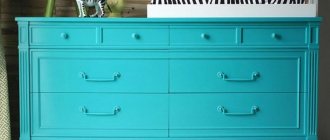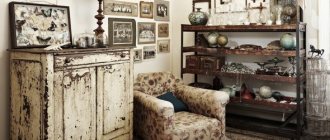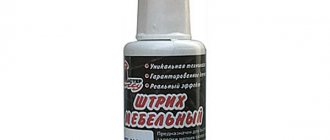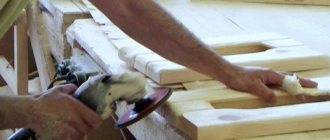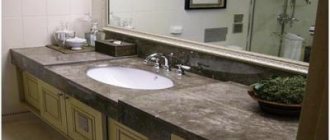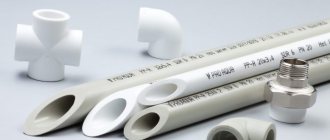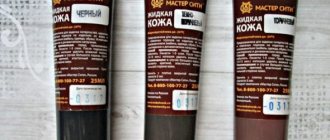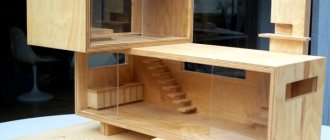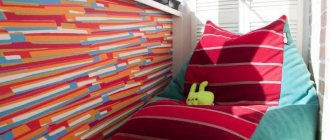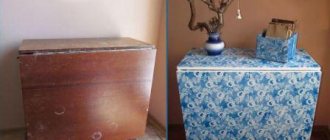What to do if your favorite furniture has lost its former shine? Is it possible to restore the varnish coating with your own hands and in what cases? Most often, the appearance can be made better and in such a way that no one will think that the furniture is many years old. Repair and restoration of furniture is a thorough work, despite the fact that you don’t need to do anything overly complicated, and some methods are so simple that anyone has the opportunity to return their furniture to its lost splendor (we are, of course, not talking about antiques), but especially In difficult cases, you can always use the services of a professional restoration workshop.
Do-it-yourself furniture repair: step-by-step 60 photos of repair and designer restoration
Furniture surrounds us in any room; these are functional structures of various shapes and designs that are used in houses and apartments.
Made from various materials, cabinet and upholstered furniture wears out over time and loses its attractive appearance, but do not rush to look for new furniture.
Simple and uncomplicated procedures, presented in the photo of the stages of DIY furniture repair, will help restore the aesthetics of structures.
Even in the event of breakage or failure of individual elements, wear of the upholstery or paintwork, you can transform old furniture without much expense, giving it a new life.
Scratches on the varnish of furniture - I hate to endure them
Hello to all readers of this blog “build a house”. It’s great that you decided to take a look, because today I decided to make a small digression and write an article not about construction, not about interior renovation, but about restoring varnish coatings on furniture .
Over the years, the once pleasing wooden polished furniture becomes dull , acquires scratches, chips and is far from its original condition. Is it possible to restore things that are dear to us to their original rich appearance? How, and most importantly, what needs to be done for this?
An alternative to an expensive purchase: furniture repair
Practical and cost-effective repair of old furniture with your own hands can significantly save your family budget.
Simple procedures are selected based on the complexity of the damage and the necessary measures to restore the appearance of the structure; the following technologies can be applied to cabinet and upholstered furniture:
- replacement of upholstery, internal filling and springs;
- installation of updated countertops or facades;
- painting surfaces, treating them with varnish;
- decorating wood with drawings or decoupage;
- restoration of functionality by replacing fittings.
Each option allows you to restore the functionality or aesthetics of the design, they can be mixed and matched to achieve the desired result.
Using simple techniques and methods, you can make a real masterpiece worthy of interior design from an old cabinet or chair, sofa or nightstand.
How to hide deep cracks
Very noticeable damage to furniture cannot be easily hidden with improvised means. To restore the original appearance and restoration requires a comprehensive approach to solving the problem.
Preparing the site
Before starting work, you need to thoroughly clean the surface of the furniture from dust and dirt. The cleaned area is coated with a degreasing agent and allowed to dry. Also at the preparation stage, you need to decide what material will be used to hide defects.
Applying the material
The purchased material is applied with a suitable tool or cotton pad to the damaged area. When applying, try to ensure uniformity. Excess material is carefully removed with a spatula.
Grouting the surface
After treating the scratched areas, you need to wipe the surface. During this procedure, the furniture coating becomes smoother and more even. As a rule, fine-grained sandpaper is used for grouting.
Painting
A layer of paint is applied on top of the applied masking material, which matches the color of the rest of the furniture. Paint not only visually hides defects, but also provides additional protection against new damage.
Repair and restoration of furniture structures
The exciting and creative process of remaking furniture, or repairing and restoring it, can be an excellent hobby for those who love manual labor.
Even a novice craftsman can master simple techniques, such as painting and sewing covers for upholstery, applying paint and varnish and replacing individual elements.
High-quality reupholstery of furniture with your own hands or restoration of varnished coating allows you to save your family budget.
The owner of old chairs and a table will not have to spend money on new furniture; it is enough to update the finish and decorate the set in a single style that matches the interior design of the home.
Interior placement options
Any table decorated with your own hands acquires bright, characteristic features of a certain style. This is no longer mass-produced furniture, but an exclusive decorative element. But these properties, in addition to undoubted advantages, carry with them some problems. To ensure that the table does not come into dissonance with its surroundings, you need to approach its placement wisely.
If you want to put a coffee table made using the decoupage technique in the living room, you should pay attention to whether there are elements in the room that can support such decor. Soft tones and natural motifs go well with thick floral curtains
Textile upholstery of the sofa and armchairs will complete the creation of a cozy atmosphere. If dark-colored leather furniture is placed in the room, you should opt for a different decoration method.
The mosaic looks good on an open country terrace or the balcony of a city apartment. You can place such a table indoors. In the kitchen, a kitchen apron made in a similar style will help support the decor of the countertop. In the living room you should place several ethnic figurines, decorate them with paintings or masks; it is better to complement the sofa group with small pillows in bright patterned covers. You can lay a homemade rug on the floor.
You should not decorate the entire surface of the dining table with mosaics. You can create a kind of tile panel in the middle of a wooden tabletop. This will create an original and stylish table that will match the chairs. The surface around the edges will remain non-slip, so there is no need to worry about the safety of the dishes.
There is always an atmosphere of slight chaos in a child's room. While a children's play table can be bright and colorful, it's worth doing differently with a work accessory. By placing an ordinary wooden tabletop under glass, you can solve several problems at once. Glass will protect the surface from damage, and objects located under it will help in studying. Part of the composition may include spelling and counting rules, lesson schedules, daily routines, or sports results. Such decor will put the child in a working mood and help him concentrate.
A table artificially aged using the craquelure technique will complement a classic-style office. Shelves with books, a floor lamp with soft light, a chair for reading books and a cracked table surface will create a feeling of peace and tranquility. After a hard day at work, in such a room you can relax and restore peace of mind.
Using painting, you can combine the table with curtains, bedspreads and upholstery. It is preferable to use finishes that match the interior elements.
Whatever method and material is chosen, a table decorated with your own hands will be a bright and unique piece of furniture. It will reflect the individuality of the owner, help unleash creativity and add exclusivity to the room.
In the next video you will find a master class on decoupage.
Replacement of accessories
To restore the functionality of furniture, you can use modern fittings, fasteners and guides.
By complementing an old coffee table with railings and a pull-out shelf, you can transform it into a table for a laptop; such an impromptu workplace will not take up much space and will help to highlight a work area in the living room.
How to paint lacquered furniture. Step-by-step instructions with illustrations
I continue to decorate my room and in this post I wanted to talk about how I repainted the furniture.
If you remember, I started by deciding on the general mood of the room, the color palette and creating a moodboard. I wrote about this stage in detail here. The second stage was painting the furniture. The furniture in my room is very old. She's probably the same age as me (yes, she's also thirty-flirty-and-fabulous). Of course, there was an option to sell it for pennies on Avito or even just take it to the trash. But I thought this was a great chance to experiment with painting furniture. In the end, if nothing works out at all, then I will always have time to throw it away.
To paint lacquered furniture I used:
- sponge with sandpaper;
- the cheapest brushes (set of three);
- two liter cans of Dulux Aqua paint (white and coral, I chose the color in the store based on palettes - about 1000 rubles per can);
- two cans of matte gold paint;
- two packs of masking tape;
- white spirit and countless newspapers.
I had a bedside table, a wardrobe and a cabinet with a trellis. I chose a rather complicated painting method (to begin with, of course, it would be better to choose something simpler - paint everything one color). In my case, the main color was white, coral inserts on the fronts and gold accents. So here's my step-by-step guide to repainting old laminated furniture.
Restoring a varnished wooden table yourself
Furniture that is varnished comes back into use. After all, lacquered products look rich and add originality and solidity to the interior. Although, to be honest, its surface is quite problematic. It can be easily damaged. A very common defect is scratches. You should not immediately get rid of the damaged table, but should try to restore it. You can entrust this process to master restorers or try to restore a lacquered table with your own hands.
Features of working with glass surfaces
In order not to damage the fragile glass surface, you need to take into account a number of nuances during processing. The main rule is to be careful. It is also important to select suitable products that do not harm glass products to complete the work.
Paste GOI
Deep scratches on glass can be removed using GOI paste. If possible, glass should be removed from furniture for ease of processing. A small amount of paste is applied to the fabric and spread over the surface. Then rub the product in a circular motion into the damaged areas. Remains of GOI paste after treatment are removed with a damp cloth.
Nail polish
Minor scratches on the glass coating can be easily masked with nail polish. A prerequisite is the transparency of the varnish. The substance must be applied with a brush to the scratched areas and wait until the varnish fills the crack and dries. The remaining varnish is carefully wiped off the surface with a soft cloth.
Restoration technique
Let's figure out how to restore a varnished table using the restoration method. This is one of the best ways to restore a decent appearance to a lacquered table. For example, to eliminate scratches, it is necessary to remove a layer of varnish on the defective areas, and then apply a new one. This method is quite effective and allows you to get rid of any scratches. But not only scratches are a problem for lacquered furniture. The next drawback that may appear over time is the darkening of the varnished surface. As a result of clouding of the surface of the tabletop, the appearance of the table begins to lose significantly in relation to other furniture. This defect can be corrected in a similar way: removing the old layer of varnish and reapplying a new one. This method is quite simple, and it is quite possible to varnish an old table with your own hands.
Drying rules
Paint or varnish takes a long time to dry. You need to take care in advance about the place where this will happen. The room must be non-residential and well ventilated. It is advisable for the furniture to dry away from children and animals, who could accidentally disturb the appearance of the coating. Some varnishes and enamels, when dry, emit harmful fumes that can be harmful to health.
After the first layer has dried, apply the coloring composition again - this will create the most uniform and durable coating.
On average, paints and varnishes require one to two days to dry. The instructions for the paint or varnish indicate the optimal drying time at certain temperatures. As a rule, the temperature regime for drying is considered favorable at 20-23 degrees Celsius.
The lower the ambient temperature, the longer it will take the furniture to dry.
DIY furniture restoration
DIY furniture repair is sometimes simply necessary. No matter how high-quality our furniture is, it still loses its “marketable appearance” over time under the influence of physical stress and the influence of the environment (humidity, heat).
This is when a paradoxical situation is created: the furniture seems to be new, but it’s too early to change it, which means it’s time to repair the furniture at home.
Of course, it is better to fix complex damage professionally, in a woodworking workshop. But most of the problems are not caused by them, but by minor defects - abrasions, cracks, chips at the corners, damage to the paintwork.
Very often, even a minor scratch can ruin the appearance of the entire interior - which means that the skills of prompt furniture repair will not hurt you.
So, let's figure out how you can repair wooden furniture yourself.
Furniture repair is a fairly simple task that even a non-professional can do. There is almost no need for special skills for this, and if you know at least the basics
We fix minor defects
Here is a list of the most common injuries, as well as ways to solve them:
- The most common type of such defects is damage (crack, scratch or abrasion) to the paintwork. In order to restore minor damage to the varnish, wipe the surface of the product with a cloth swab dipped in a mixture of linseed oil and alcohol in a 1:1 ratio. After this, after waiting for the surface to dry completely, we polish it to a shine using a clean cloth.
If the varnished surface is damaged deeply enough (the deep layers of the varnish are affected), then we cover the damaged area with a layer of plain varnish, dry it and polish it with a cloth.
Most often, repairing old furniture with your own hands is done this way.
Note! If shellac varnish was used, then for polishing it is advisable to use a mixture of GOI paste with kerosene, or a mixture of linseed oil and alcohol. If the surface was coated with a nitro-varnish-based composition, then to achieve the best polishing effect, use a 1:1 mixture of alcohol and solvent.
- When we find stains on a varnished surface, we first determine their origin. If this fails (most often this is what happens), wipe the stain with a cloth swab dipped in gasoline. If necessary (for example, if after the gasoline has dried, a fragment of the stain remains on the furniture), repeat the operation after some time. After the polished surface is cleaned, wipe it with a cloth until it shines. We restore the polish that was damaged during stain removal by wiping the furniture with a mixture of denatured alcohol and linseed oil.
- If a stain from a hot object (kettle, pan or iron) has formed on a polished surface, remove it by wiping the damaged area with a swab dipped in alcohol, after which we restore the polish. If the damage is severe enough, such a stain can be removed by polishing with a mixture of drying oil and alcohol. After there are no traces of the stain left, be sure to wipe the surface with a swab dipped in pure alcohol, and then polish it with a cloth.
Assessment of the degree of coating wear
After looking at numerous photos before and after restoration, many people are inspired. After that, they try to work on improving their own furniture.
I can say that it is no more difficult than restoring a mirror. But it’s not easier compared to repairing wooden chairs. We have already talked about these procedures, and therefore I suggest you follow the links and read our materials, leave reviews and share your personal experience.
At the first stage of restoration, it is necessary to visually assess the current condition of the surfaces. The first sign is visual aging. Darkening often appears near threaded connections, the varnish cracks, and a large number of chips can also form. The aging of the varnish and the end of its life cycle are indicated by small meshes on the surface. Yes, small defects do not always significantly affect the overall picture.
But there are also cases when simply removing the old layer and applying a new coating cannot be done.
Consider whether restoration makes sense. If yes, then get to work.
If the varnish is damaged significantly
However, all of the above methods only work for minor damage to lacquered furniture. What to do if the varnish is damaged quite badly?
In this case, you can use a special remover purchased at a hardware store. Various removers are used to remove nitrocellulose, polyester, and oil-based paints and varnishes.
The most effective in such matters as restoration or repair of wooden furniture are emulsion removers (for example, SM-1 or SM-2). They are low-toxic and virtually eliminate the risk of fire, which is especially important if you are repairing furniture right in your own apartment.
Removers of this class destroy the coating in one go, without requiring re-application, while for polyester varnish the exposure time of the remover reaches two hours, and for alcohol or nitrocellulose varnishes, you can begin removing the varnish within 25-30 minutes after applying the remover.
We use the wash as follows:
- On the varnished coating (for example, the wall of a cabinet, opened with polyester varnish), we apply a mesh of scratches (in the form of cells with a side of 15-20 mm).
- Apply the remover in an even layer, after which we cover the treated surface with waxed or paraffin paper.
- After the necessary exposure (remember, it depends on the type of paint coating), carefully remove the softened varnish with a spatula, trying not to damage the wooden base.
- We wash the surface cleaned of varnish with a solvent and dry it for about an hour and a half.
- We sand the dried surface with sandpapers No. 5 and No. 6, and then remove dust.
- After the wood dust has been completely removed from the surface, we begin to restore the varnish layer.
Selection of materials
To restore furniture from materials you will need remover, paint and varnish. First of all, to remove the old layer of paintwork, a wash will be required. This is a special composition that dissolves paint and varnish, making them plastic, ready for mechanical removal. The wash contains very aggressive acids, so you only need to work with it in a protective suit and mask. Contact of the material with the skin causes a strong burning sensation; prolonged exposure may cause burns. But the remover makes it easier to remove the varnish yourself when it is not possible to use a grinder or a hair dryer to heat the material.
When choosing a wash, you should pay attention to its consistency. If you need to remove varnish from the horizontal part of furniture, then a liquid composition is suitable. For vertical parts, it is better to choose a creamy or paste-like remover. This material does not flow down and dissolves varnish and paint well. For global work, choose a remover in powder form. It has low consumption and a long shelf life.
The second material required is paint. If you want to radically update your furniture by changing its color, then you can’t do without paint. What material can be used:
- Acrylic paint. The most popular type of paint and varnish materials. It has good fluidity and coverage. It fills all cracks and scratches and fits perfectly on surfaces.
- Water-based paint. In confined spaces, it is better to use water-based paint. It dries quickly and has no pungent odor. But the finished surface turns out matte, and the paint itself is easily washed off with plain water.
Stain. A budget option to paint furniture. The stain is suitable for items made of expensive wood with a beautiful grain pattern. This material does not completely paint the surface, but rather covers the wood grain.
At the final stage of restoration, varnish will be required. Several types of this material are used to restore furniture:
- Shellac polish. This varnish emphasizes the beautiful structure of the wood, while the consistency is like water. To obtain an original, noble shade, the surface is covered with varnish in 40-60 layers.
- Nitrocellulose varnish. This material is not suitable for home use. This varnish is suitable for treating large areas. To treat surfaces, a special spray gun is used that supplies the material at a certain speed. If you apply the varnish at a slower speed, its particles will harden individually, forming bubbles on the surface. The difficulty of applying this material makes it almost impossible to use it outside the workshop.
Repair of cabinet furniture - tips
However, sometimes repair work is not limited to restoring the appearance of furniture. Then you have to take the repair of old furniture seriously - especially since in most cases you can do such work:
- Quite often, cabinet doors either open with great difficulty, or, conversely, tend to open spontaneously. This is often due to the fact that the cabinet has become warped over time and is not completely horizontal. To eliminate this, we place a thin wooden plate on one of the cabinet legs, selecting its thickness using a level.
- If the cabinet has impressive dimensions, then the floor may sag under its pressure. In this case, we hammer two spacers (wooden rollers) under the bottom of the cabinet so that they are not visible from the front.
- However, cabinet doors can also become capricious due to weakened hinges. In this case, we either tighten the hinges or replace the mounting screws with longer ones (as far as the thickness of the cabinet walls allows). We fill the holes in the fastening screws that have become damaged over time with wood putty or a mixture of such putty and sawdust.
- Very often, repairing kitchen furniture with your own hands requires removing jams from numerous pull-out cabinets. You can fix the problem by rubbing the runners of such drawers with paraffin or candle wax, and if they swell over time with kitchen moisture, then grind off the rubbing surface of the guide strip with sandpaper.
Applying glue to a chair leg
We disassemble dry and loose chairs and armchairs and clean off any remaining glue from the joints. Then we apply wood glue to the parts to be joined and fix them, pressing firmly on the gluing area. Drops of glue flowing from the joint must be removed immediately - otherwise an unpleasant stain may remain on the surface of the furniture. A day after gluing, the chair can already be used!
With these simple manipulations, you can significantly extend the life of your furniture, which means you will also save the money you need to buy new ones. And if you master all the intricacies, then repairing furniture with your own hands can turn into a hobby that brings your family a good income.
Application of special products
If the furniture has been in use for many years, and the owner wants to return it to its former beauty, then you can purchase special coatings, which will give the product a second life. Let's look at the best of these.
Varnish
This product is made from shellac polish and perfectly restores the shine of varnish coatings. It gives them additional:
- grace,
- new original shade.
Having bought yourself a jar of such a solution, you can begin processing. As a rule, it requires about 40-50 layers. In this case, you will be able to achieve all of the above effects.
Nitrocellulose based varnish
The solution is well suited for restoring large areas of damaged old varnish. Despite its availability, the disadvantage of this product is the need to use a special sprayer to work with it.
Alternatively, you can buy such a tool for yourself or ask to rent it from the appropriate workshop.
Pentaphthalic varnish
Almost ideal for restoration. It is easy to use; applying it to coatings does not require any special knowledge or skills. The varnish dries quickly, which gives it another significant advantage.
